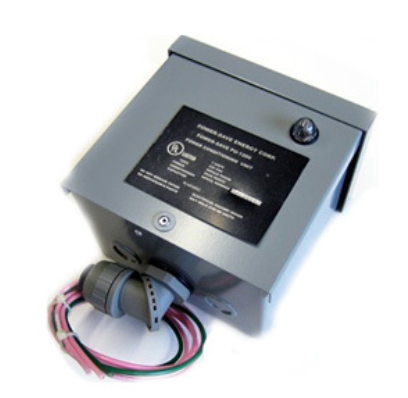 The “Power Save 1200” claims to reduce your electricity bill by using capacitors to alter the power factor of the electricity being consumed in your home. It further claims that an improved power factor will extend the life of electrical devices, help electrical motors run more efficiently, save light bulbs and eliminate static interference.
The “Power Save 1200” claims to reduce your electricity bill by using capacitors to alter the power factor of the electricity being consumed in your home. It further claims that an improved power factor will extend the life of electrical devices, help electrical motors run more efficiently, save light bulbs and eliminate static interference.
It is important that we are clear on the distinction between a product that scams consumers by exaggerated claims of electricity saving through Power Factor Correction (pfc) and a product that scams consumers by claiming it does pfc when it does not. We are of the opinion that the Power Save 1200 is capable of power factor correction – but consider it a scam when proposed for residential use.
It is also important to understand that the issues we raise are only applicable to home owners. Commercial companies and industrial users do require power factor correction for the improved reliability of their electrical equipment, to save electricity, and to save on their electrical bill
Separating truth from fiction
There is truth in the fact that our homes have devices which consume electricity at lower power factors. As an example we know that CFL light bulbs have a Power factor of between 55% and 70%, while incandescent light bulbs have a power factor of 100%. All electric motors, including fridges, air conditioners, fans and computers generate reactive power which will affect their power factor.
Based on the above information it could sound logical that a pfc technology would save money for a home owner. But this is NOT a correct conclusion at all. Improving a consumers power factor will mostly save a “negligible” amount of electricity. I have corrected my earlier opinion of “NO saving” to “usually negligible” thanks to an informative discussion with the founder of V-Blox Mr David Mulvaney.
Go to the source
Mr Mulvaney contacted me regarding his company and said “I want you to know we do not recommend power factor correction in homes and I will be the first to tell you that savings if any would be negligible”. Noticing that his company is on a list of “imitation KVAR products” published by a KVAR distributor, I listened to his version of the story. I will be writing a separate posting on how it seems that the real pfc scams have developed. I did find all he said to be professional and reasonable.
Mr Steve Fish, CEO of KVAR Energy Savings Inc. also contacted me. He said “we are a professional organization and will take back any KVAR product that fails to reduce the electricity bill by less than our guarantee of 6%”. According to KVAR, they capture and store the reactive power (var’s) generated by an electric motors while it runs. We have agreed to conduct tests with KVAR to quantify any reduction in electricity by storing these “captured” vars in a capacitor, and serving them to the motors when required.
There is clearly an issue here, and both CEO’s did acknowledge that their resellers were capable of “overzealous selling” – I suggest that all consumers be vigilant when investigating “var” or KVAR related savings in their home.
Understand what you’re paying for
When the power factor is less than 100% it means that there is a phase shift between voltage and current. Consumer tariffs are based on Real Power, only the electricity actually consumed by a device. The consumer electrical tariffs include provision for the losses which this “out of phase” might cause the electricity supplier.
It is true that electricity suppliers need to manage their distribution networks, and that power factor IS one of the factors that impacts their distribution losses. It is also true that large industrial users are charged a penalty for a net power factor of less than 85%. But distribution losses will not typically be solved by consumers. They are aggregate issues that can only be solved by the utility companies “the smart grid” in partnership with industry and device manufacturers.
Power factor and power factor correction are indeed subjects that we should be aware of, but it is “near fraud” when excessively marketed to home owners as a way to save money on their electricity bill.
Buyer beware—or else
One of the most disheartening aspects of all these scams is the amount of money the perpetrators seem to have for promoting and advertising them. As an open source publisher, dependent on contributions and advertising to pay our way, there is little more frustrating to me than the way Google is being abused to promote these scams. I understand that there is little they can actually do about it, for they are not the internet value police, and imagine how we would feel if they did make value judgments on our content.
I believe the answer is for us publishers to block all adverts from these scam domains. And for our readers to value our content with your visits, comments and links. Think of reading these pages as being a part of a virtual internet energy scam watch, where you can help expose their theft and send it to the black hole of “never seen” internet search results.
Guest post by Alexander Bischoff, Open4Energy


